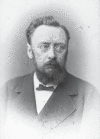Contributions to Progress in Ophthalmology from Switzerland: From the 16th to the 21st Century
- PMID: 32836218
- PMCID: PMC8006591
- DOI: 10.1159/000511057
Contributions to Progress in Ophthalmology from Switzerland: From the 16th to the 21st Century
Abstract
There are numerous contributions to the development of ophthalmology from Switzerland, a country that holds a very special place in the history of medicine from the age of Paracelsus and Vesal to the current time. This review gives an overview over these contributions and the pioneers, among them Johann Friedrich Horner, Hans Goldmann, Jules Gonin, and Walter Rudolf Hess, one of only two ophthalmologists ever awarded the Nobel Prize for Medicine. A leading role in this evolution of modern ophthalmology has been played by physicians from Basel, home of Switzerland's oldest university.
Keywords: Cataract; Flammer syndrome; Glaucoma; History of ophthalmology; Laser; Minimally invasive strabismus surgery; Perimetry; Retinal detachment; Retinoblastoma; Slit lamp; Swiss medicine.
© 2020 The Author(s) Published by S. Karger AG, Basel.
Conflict of interest statement
R.D.G. has no financial interests and is not employed by or a consultant for any company.
Figures










References
-
- Benchmarking the Power List. The Ophthalmologist; 2018.
-
- Vesalius A. On the Fabric of the Human Body, translated by Richardson WF and Carman JB. 5 vols. San Francisco and Novato: Norman Publishing; 1998–2009.
-
- Vesalius A, The Fabric of the Human Body . Translated by Harrison DH and Hast MH. Basel: Karger; 2013. An Annotated Translation of the 1543 and 1555 Editions of “De Humani Corporis Fabrica Libri Septem”.
-
- Debus AG. Paracelsus and the medical revolution of the Renaissance: a 500th anniversary celebration. Bethesda: National Institutes of Health; 1993.
-
- Keller HE. Jakob Ruf. Leben, Werk und Studien. Zürich: NZZ Libro; 2008.
Publication types
MeSH terms
LinkOut - more resources
Full Text Sources

